Circle trips are good trips; new adventures
are always ahead and there need be no retracing of steps. In El Salvador the big car brand seems to be
KIA. Our rental car proved to be a Kia
Soul, an automobile with a motor not much more powerful than our boat bilge
pump. With the engine screaming like a
race car we hit the road for an 8 day tour.
As in Mexico, driving in El Salvador requires a
combination of patience and iron nerves.
The roads are mostly single lane and very windy, with a wide mix of fast
and slow vehicles. Sugarcane trucks, 3-wheeled
tuk-tuks and farm vehicles are often parked or moving slowly on the road shoulders.
The widely accepted driving practise is to pass using the “faith-in-god
technique”. To drivers schooled in more
rule-driven methods the condition becomes one of hyperactive vigilance: at all
times you need to be primed for an imminent driving crisis to suddenly jump out
from a blind spot. With a potential road
crash at all times seconds away, the calm voice of the Google map lady has
proven to be essential. We speculate that
she and her counterparts all over the world are actively preserving marriages
that otherwise would surely be foundering.
Stuck behind another sugarcane truck.
Many Volcanos
The Salvadoran sky-scape is punctuated by
numerous volcanic peaks and periodic explosive eruptions have played a major
role in the area history, from the times of the Maya and into modernity. Viewed from the Bahia del Sol estuary, the
prominent massif is a double-coned formation that appears as a shapely set of
breasts. It is called Volcan de San
Vicente, but it is more usually called Chinchontepec , which boyishly translates
to “mountain of two breasts.” Our first stop was on its eastern slopes – for a
lunch break in the church square of San Vicente. We were struck there by the sight of a simply
humongous 500 metre long queue of elderly men and women, cowboy hats galore, in
a line that wrapped around the block.
They were all patiently waiting to enter a bank, to what purpose we
never learned with certainty, though it was later suggested that in the lead-up
to the presidential election a newly available rural pension cheque might have
been issuing inside.
One-one-thousandth of a bank line
The extremely charming town of Suchitoto
awaited us after our first day driving.
Clean, well-kept and colourfully painted residences line the cobbled
streets. Our late afternoon stroll after
hotel check-in found us randomly stumbling upon the quietly spectacular deck of
the Restaurante el Mirador. Expecting
our cervesas to be served on a non-descript table, the cliff-edge view of the completely-invisible-from-the-street
lake below was incredible.
Main church square
Choir boy statue
Street scenes
Lounging outside our Suchitoto room
|Street scenes
Street scenes
"In this house we want a life free of violence towards women." This phrase is stenciled on many of the walls in Suchitoto. Leaving aside those encouraging words, note the old bullet pock-marks on the wall...
Street scenes
Suchitoto offers attractive tourism
opportunities, but overwrought international fear mongering and travel
advisories have proven highly effective in keeping the crowds away. We woke for a 6am morning bird watching tour
down on the lake. The two of us were
guided by our English speaking guide Robert, by Melvin the expert naturalist,
and by our panga driver, Edwardo. Both
of us being incompetents in the subject of bird-watching, we were still pleased
to see and have so many birds identified for us.
Bird touring
The afternoon brought a little shopping
(indigo dress for Alice), an otherwise nice dinner at a Tex-Mex styled
restaurante but where the Mexican art of Margarita making has fallen into a
condition of “lost art.” This drinking disappointment was amiably rectified
later that evening at the El Necio bar, where we took shots of rum and
moonshine with Billy the bartender and with Gerry, an aging veteran FMLN rebel
fighter. Bar El Necio has a character
that exudes rustic authenticity, conveyed distinctively in the form of a
bare-planked bar, lashed-together stools, earthen floors and a rusting tin roof
structure. They with no English and we
with our less than rudimentary Spanish made for a sort of communion that only
lubrication can remedy. By the end of
the evening we were best of friends with Gerry and we understood each other
perfectly…
A poster in Bar El Necio. Women were considered the bravest fighters of all.
The following day was all about the 1980-1992
civil war. Near Suchitoto is the
mountain village of Cinquera, which was bombed to oblivion and abandoned. The majority of the town was taking refuge in
the church when it suffered a devastating direct hit. Rebel fighters from the area regrouped in the
nearby mountain forests, where we were guided on a very interesting walking
tour by a metal band rocker and affable young conversationalist named Daniel. The tour began by sitting down with a rebel
veteran fighter (Daniel translating) who first trained at 16 years of age in Cuba. There he learned Vietnamese jungle fighting
techniques so as to properly lead his troop of fighters. World geopolitics was
in major play back in the 1980’s: funding and armaments to fuel the conflict came
from around the world, with the US backing the right-wing government and the
communist bloc the rebels. At least
80,000 dead was the consequence and since the 1992 truce El Salvador has been
in rebuilding mode, scars of war fading slowly but not yet forgotten.
Alice posing with an a rebel veteran leader.
Daniel showing us the kitchen of the rebel fighters. The smoke was tunneled underground to seep out undetected away from the kitchen camp.
The rebel hospital deep in the Cinquera woods. This was the operating table.
Guns from the civil war were disabled by the United Nations as part of the peace keeping process.
The village church rebuilt many years after being destroyed by bombs dropped by the military. The villagers were seeking refuge in the church and not many survived.
The rebels proudly brought down this fighter helicopter supplied to the right-wing military by the US government. As with many of the military's weapons, it previously saw action in the Vietnam war.
This mural in the main village square depicts first a beautiful rural economy, then the tragedies of the civil including the torturing of village women, and finally the peace treaty.
Cotton Trees
Two hours drive onwards, in Santa Ana, is a
city of beautiful Spanish European influenced architecture (both intact and
crumbling). The main square is fronted
by an impressive Cathedral and Theater.
A pleasant dinner can be had there overlooking the night-lit buildings
at the restaurante Simmer Down. Yet in this area it is nature’s architecture
that stands most impressively. Hiking
the Volcan de Santa Ana our hot exertions were rewarded by a view of the huge
caldera with its stinky green steaming lake far below, laying at the bottom of
the shear drop edge of the crater wall. Afterwards we drove a little distance
away for a cooling off dinner where we enjoyed the view of another even more
gigantic lake caldera, Lago de Coatepeque.
The explosion would have been epic indeed that formed this now serene 5km
diameter lake with its dockside homes for the local wealthy.
The Cathedral of our Lady Saint Anne.
Teatro de Santa Ana
A typical Santa Ana store front.
Strings of Salvadorian meat balls in the Santa Ana market.
Beautiful but neglected architecture everywhere in Santa Ana.
Pretty crinoline dresses for the little girls.
The dairy shop, obviously.
Santa Ana market
View of Santa Ana from the room top of the Casa Verde Hostel.
Hike up to the summit of the Santa Ana Volcano - 2,381 metres
This young entrepreneur over passes the gringos on the trail both up and down. He had cold ice cream to sell at the summit.
Despite the fearful xenophobic stories you
may have heard or read we have found the people of El Salvador to be friendly
and ever-helpful. On a tip from Carlos
of the excellent Casa Verde hostel, we journeyed en-route to the town of Ataco,
taking a 10km detour on a rough rabbled road to the waterfalls of Salto de
Malacatiupan. These infrequently visited
by tourist falls are unique in that they flow at the absolutely perfect-for-hot-tub
temperature of 40C. Far out! (as we used
to say).
Thermal waterfalls of Salto de Malacatiupan
The Tazumal site was occupied by the Mayans from 1200 BC.
The geothermal potential of the Ataco area
has been developed and 15% of El Salvador’s energy is produced using this
natural resource. The area is also coffee-bean central and this means both good
brew is available in the mornings and of course, a tour of the coffee bean
processing plant. Very interesting 1930’s era equipment is used, though the
strongest memory imprint of the tour came from watching the line of 14 women
pick sub-standard beans from a conveyor belt.
Eight hour days of the most tediously repetitive work we have ever seen
is compensated by daily wages of $8.00 (the minimum wage here). The bliss of morning coffee ought never to be
the same for us, yet already our guilt fades under the silk-sheeted blanket of our
every day privilege.
Enjoying a latte at our modest hotel in Ataco.
Ataco murals everywhere.
A short morning hike to El Mirador de la Cruz provides good views of Ataco.
Brightly painted shops in Ataco.
Kids all over the world enjoy a pop and their toys.
Sight seeing party bus in Ataco.
Greg lost in the coffee bean stores.
Women working for $8.00 a day sorting out the less than perfect coffee beans. Every 30 - 60 seconds the conveyor belt brought them a new pile to sort. Greg and I agreed it appeared to be the worst job in the whole world.
By every road since departure we had been
climbing. Leaving Ataco we stopped for
brunch in the garden of the Celeste de Jardin, before reaching the summit of
our trip in Juayua. Sundays are known
for their food festival and people travel from near and far to enjoy plates of
food served in the square. After
choosing a plate for lunch, we trekked downhill to another system of waterfalls
and cheated on the return trip by hailing a tuk-tuk. Not being much hungry
anymore, our dinner was a small meal of pupusas (corn-flour tortillas stuffed
with cheese or meats) at $0.25-0.35 each.
Brunch at the lovely Celeste de Jardin.
Flower petals
A typical room on our road trip.
Greg enjoying the gardens at Hotel Anahuac in Juayua.
Joining the weekend crowd at Los Chorros de Callera waterfalls near Juayua.
Unfortunately, the local street foods
brought Alice a stomach bug and crappy feelings for the next 48 hours. Such is the pleasure and sometimes stomach pain
hazard of travel. Declaring herself fit for the road we zoomed downhill towards
San Salvador where Greg was seeking hard to find plumbing parts and Alice could
complete her recuperation in a comfy citified bed. She felt just good enough
that evening to try a beer flight at the nearby Cadejo Brewing Company. By morning she was recovered and shopped at
Kreefs, a German deli. Life on the boat
involves frequent evening invites for drinks and at those events appetizers are
required. Ingredients for good appies
are darned hard to find in coastal village tiendas, so a German deli must never
be passed over.
With another shopping stop at a Super
Selectos supermarket and a 1-1/2 hour drive back to the boat, our road trip was
complete and declared a happy success.
More of El Salvador will most certainly be in our future plans.
Greg & Alice










































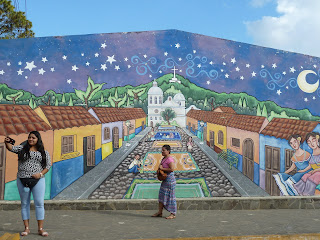
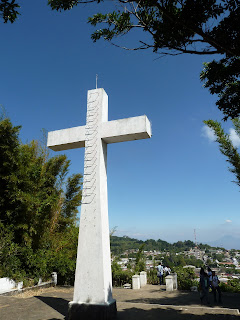



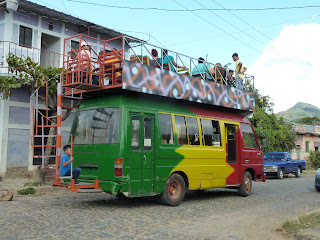



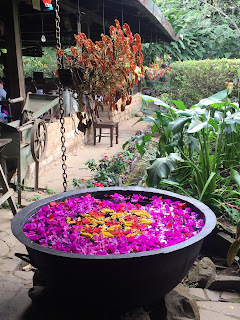





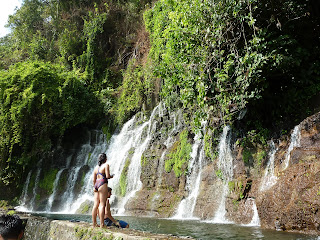
No comments:
Post a Comment